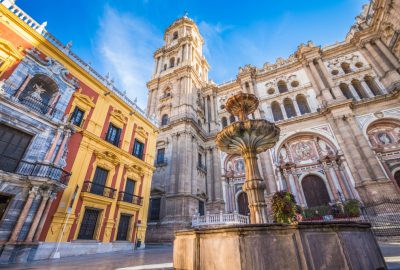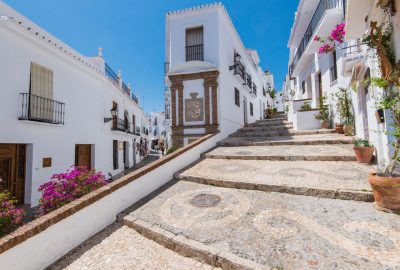I have very warm childhood memories involving Málaga. Not the city, mind you, but a type of chocolate candy. It had this creamy filling with chopped raisins. It was also spiked with alcohol and I probably shouldn’t have had any of that back then. Why was it even called “Malaga”? No one knows. Probably just because it sounded cool and exotic. Those two words perfectly describe this city. Málaga is the quintessential Mediterranean destination. Thoroughly Spanish but with clear Arabic and ancient Roman flavours. Locals say that it’s sunny for over 300 days a year. They’re not wrong. It’s also very hot here, as Málaga is shielded from cold winds by mountain ranges. You can see their outline from the Port, one of the most popular districts of this city. The water is warm enough to bathe all year round. The bay is huge and you’ll immediately notice how everything is spread alongside it.
All those tiny cafes and restaurants used to belong to the fishermen. Fishing on a small scale isn’t much of a thing nowadays, so they repurposed. Now they sell some of the best paella and grilled sardines in the world. Fresh produce and even more food can be found at the Atarazanas Market (Mercado Central de Ataranzas). It used to be a shipyard of Arabic origin, hence the exotic name. Now it’s divided into three parts selling different stuff. There’s one for fish stands, one for meat, and one for fruit and vegetables. The middle of the hall is reserved for an incredible tapas bar. They cook using the freshest ingredients bought on demand. Don’t forget to try the Iberian ham. It’s expensive, but the crowd is so wild you can walk around in circles taking samples and no one will notice.

Malaga's Incarnation Cathedral, nicknamed La Manguita (The One-Armed Lady), because it has just one tower
Wash it all down with a glass of Málaga wine? Don’t mind if I do. Especially in El Pimpi, a legendary flamenco bar owned in part by Antonio Banderas. Celebrities line up for a table in this place. There’s even a sizeable collection of autographs on barrels filled with that sweet local wine. It’s quite an experience. The bodega almost feels like a museum. Visit around early afternoon if you want to explore and make sure you see the terrace. The view from the top is mind-blowing. You’ll see the Picasso museum and his birthplace, both are popular tourist attractions.
The Roman Amphitheatre (Teatro Romano de Málaga) and the Alcazaba Fortress will instantly catch your eye. Those two are the symbolic contrast between different civilizations that ruled the region. Imagine an ancient Roman amphitheater and an Arabic fortress on top of one another. It’s an awesome sight. A Christian church is just around the corner. Not just any church, mind you, but the famous Cathedral of Málaga. It's also known as the Incarnation Cathedral (Catedral de la Encarnación de Málaga) or La Manguita, which stands for "The One-Armed Lady". Why the nickname? It only has one tower. There isn’t much of a story behind it, it was just never finished. Cortijo Jurado, also known as Casa Encantada, outside of Málaga has a story, though. It’s supposed to be one of the most haunted houses on the planet. The area was originally a farm. The mansion was built in the 1900s by the Heredia family. Rumour has it that it’s connected to neighbouring residences by an elaborate network of tunnels. It stands abandoned now, and people weave stories about corpses buried on the property.

The Spanish region of Andalusia is known for its white villages (pueblos blancos) such as Frigiliana
Gibraltar is a two hour drive away from Málaga. It’s definitely worth a day trip if you haven’t seen it yet. Frigiliana is even closer. It is known as Spain’s most beautiful and well-preserved village. People also call it “the white village”, because it’s white. Before you start to think it’s a racist thing: the buildings are all white because that’s what people did back then. They used slaked lime to “whitewash” the walls. It was very popular especially during plagues, due to its mildly antibacterial properties. Not a unique site by any means; these pueblos blancos are all over Andalusia. Frigiliana is actually home to the Festival Frigiliana Tres Culturas (Festival of the Three Cultures), celebrating the joined communities of Christians, Muslims and Jews.



No one commented yet. Be the first.